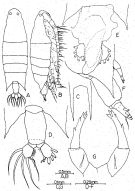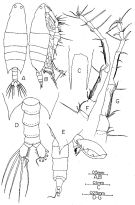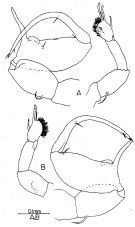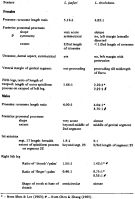|
|
 |
Fiche d'espèce de Copépode |
|
|
Calanoida ( Ordre ) |
|
|
|
Diaptomoidea ( Superfamille ) |
|
|
|
Pontellidae ( Famille ) |
|
|
|
Labidocera ( Genre ) |
|
|
| |
Labidocera jaafari Othman, 1986 (F,M) | |
| | | | | | | Ref.: | | | Othman, 1986 (p.193, Descr.F,M, figs.F,M) |  issued from : B.H.R. Othman in Malay. Nat. J., 1986, 39. [p.195, Fig.1]. Female (from Straits of Malacca): A, habitus (dorsal); B, idem (lateral right side); C, rostrum; D, urosome (dorsal); E, urosome with spermatophore (ventral); F, urosome (lateral right side); G, P5. Nota: Length ratio Prosome/Urosome 5.16 : 1; prosome length /width ratio: 2.95 : 1. Without cephalic hook. Rostrum directed postero-ventrally, bifid. Eyes small, separated by c. 2,5 x the eye diameter. Head and thorax separated. A distinct indentation occurs on both lateral and dorsal profiles about midlength of the cephalosome. 4th and 5th thoracic segments fused. Posterior corners of the last thoracic segment symmetrical; the processes extend to about 2/3rd the length of the urosome. Urosome 2-segmented. Genital segment almost symmetrical, smooth. Length ratios of the urosomal segments: 66:6:28. Anal segment symmetrical and smooth. Sperm-sac situated on the left side of the urosome extending beyond the caudal rami by c. 1,5 x the length of the caudal rami. Caudal rami almost symmetrical, the right ramus only marginally longer but slightly thinner than the left. A1 24-segmented, reaching to the middle of the genital segment (when extended). A2, Md, Mx1, Mx2 and Mxp are not distinguishable from the other members of the genus. P1 to P4 uniramous and symmetrical and are without any special features. P5 uniramous and symmetrical but for the 2nd basipodal segment. The left segment is slightly longer than the right
|
 issued from : B.H.R. Othman in Malay. Nat. J., 1986, 39. [p.197, Fig.2]. Male: A, habitus (dorsal); B, idem (lateral right side); C, rostrum; D, urosome (dorsal); E, urosome (lateral right side); F-G, right A1, segments 17-24 (opposite views). Nota: Urosome 5-segmented. Genital segment slightly asymmetrical with the left margin slightly more convex than the right. Proportional lengths of urosomal somites and caudal rami as 18 : 21 : 22 : 13 : 4 :2 2 = 100. Left A1 as in the female, the right very characteristic. Segment 17 short, the anterior margin bears a row of c. 25 weakly denticles; segment 18 elongated (being c. 2.2 x length of segment 17), the anterior border with a ridge bearing a row of c. 53-55 denticles of varying shapes and sizes. The fused segments 19-21 with a ridge on the anterior border bearing a row of c. 78-80 weakly denticles. Segment 22 furnished with a rounded spiniform process extending slightly beyond segment 23.
|
 issued from : B.H.R. Othman in Malay. Nat. J., 1986, 39. [p.198, Fig.3]. Male: A, P5 (posterior); B, P5 (anterior). P5 uniramous and symmetrical. The 1st basipodal segment of the right leg is short; the 1st exopodal segment (chela) is elongated and subcylindrical, the thumb at the proximal end of the chela is narrow, conical, outwardly curved and extends c. 0.43 x the length of chela; the surface of the chela between the thumb and the junction of the end exopodal segment (finger) is straight but for a semi-circular lamella which arises near the base of the thumb.
|
 issued from : B.H.R. Othman in Malay. Nat. J., 1986, 39. [p.200, Tabl.1]. Comparisons of some features between L. jaafari and L. sinolobata.
| | | | | NZ: | 1 | | |
|
Carte de distribution de Labidocera jaafari par zones géographiques
|
| | | | Loc: | | | Indonesia-Malaysia (Straits of Malacca, Kuala Selangor and Pulau Besar)
Type locality: 3°20'N, 101°12.5'E. | | | | N: | 1 | | | | Lg.: | | | (469) F: 2,55-2,31; M: 2,29-2,14; {F: 2,31-2,55; M: 2,14-2,29} | | | | Rem.: | This species belongs to the L. detruncatagroup (Fleminger, 1967). | | | Dernière mise à jour : 06/01/2015 | |
|
|
 Toute utilisation de ce site pour une publication sera mentionnée avec la référence suivante : Toute utilisation de ce site pour une publication sera mentionnée avec la référence suivante :
Razouls C., Desreumaux N., Kouwenberg J. et de Bovée F., 2005-2025. - Biodiversité des Copépodes planctoniques marins (morphologie, répartition géographique et données biologiques). Sorbonne Université, CNRS. Disponible sur http://copepodes.obs-banyuls.fr [Accédé le 23 octobre 2025] © copyright 2005-2025 Sorbonne Université, CNRS
|
|
 |
 |







